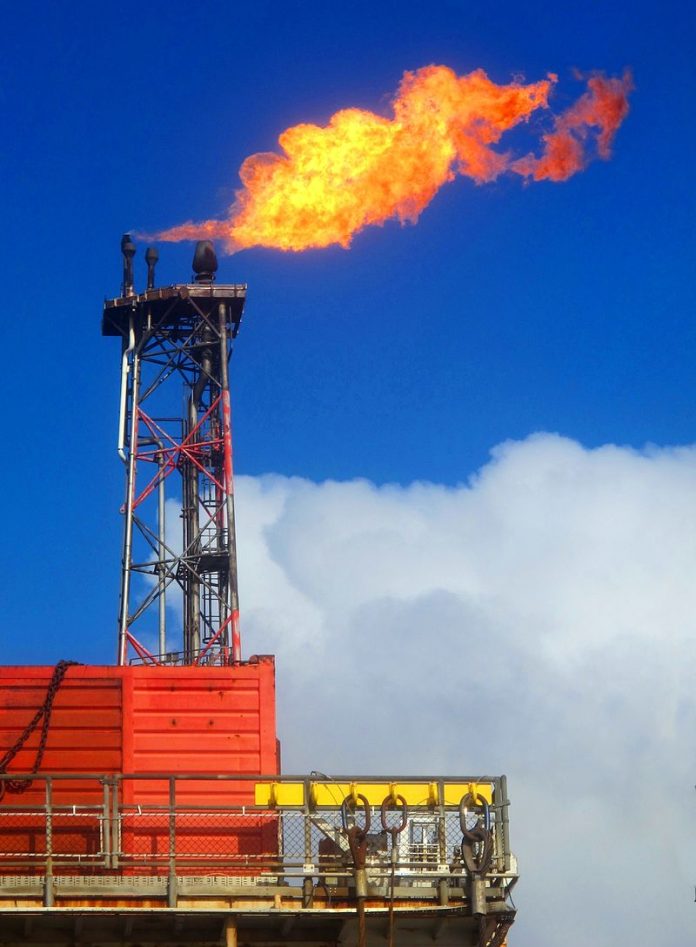Facing increasingly strict state regulation and the threat of new taxes, Texas oil and gas producers have banded to together to form the Texas Methane & Flaring Coalition (TMFC), to develop ways and co-ordinate efforts to reduce the routine flaring of natural gas.
Operators flare or burn excess natural gas, most often methane, for both safety and economic reasons. Gas is flared when there is insufficient storage space or pipeline access or capacity in order to prevent a dangerous buildups at producing sites. Operators also flare natural gas produced incidental to oil production when the cost of bringing it to market exceeds the profits available from selling it.
Fracking has produced a huge increase in natural gas production. This has resulted in persistently low natural prices, despite it being put to increasing use for electricity production and, to a more limited extent, to power vehicles. Because natural gas is valuable, operators have been finding ways to decrease flaring even without regulatory or legislative pressure to do so.
A 2019 analysis by Texans for Natural Gas reported by Natural Gas Intelligence shows even as natural gas production in the Permian Basin of Texas increased by more than 210 percent, “its flaring intensity — amount of gas flared per barrel of oil produced — declined 64 percent.”
Regulatory Pressure to Reduce Flaring
In November 2020, the Texas Railroad Commission (RRC), the agency charged with regulating oil and gas operations in the state, issued new guidelines to limit and manage flaring.
Operating under the new guidelines, in early February, the RRC rejected dozens of permits for flaring outright, remanded 14 flaring requests to agency staff for additional review, and approved dozens of other permits to for temporary flaring.
Commenting on the new rules and the commission’s recent permitting decisions, RRC commissioners Jim Wright and Wayne Christian told Natural Gas Intelligence although flaring may be necessary under certain circumstances, it should not become routine or the option of first resort for handling natural gas.
Under present rules, producers may flare or vent gas in the first 10 days a well is drilled, but they must receive a permit from the RRC for continued flaring beyond that time period.
“Getting an exception for our flaring rules should not be easy,” Christian said. “Staff should ask tougher questions, follow-up questions, and generally just dig deeper.”
“[Flaring is] a necessary last resort during an upset, and we have work to do internally at the commission to ensure that we are not approving requests that go beyond that,” said Wright. “[I am] amenable to allowing fair time for flaring to occur in certain circumstances, but limits must be set.”
Legislative Pressure to Reduce Flaring
Further pressure on operators to reduce flaring is coming from Democrats in the Texas House who’ve introduced bills to tax gas flared
State Rep. Vikki Goodwin (D-Austin) introduced House Bill 1494 to impose a 25 percent tax on the market value of natural gas flared or vented. Currently flared gas is exempt from state taxes normally levied on gas production because it is not sold for use.
“Texas is one of the top oil and gas producing states, and as a byproduct of pulling oil out of the ground, this gas comes out — the same gas we use in our homes to cook our food,” Goodwin said, according to Natural Gas Intelligence. “But for oil producers, they see it as a waste product.
“Rather than figuring out how to sell it or how to use it onsite, they’re basically just throwing it away,” Godwin said.
The publication The Texan has estimated, “based on 2019 production, flaring, and price data, the state would have collected $145 million from the tax.”
Actively Working to Reduce Flaring
Responding to the RCC’s and the legislature’s actions, the TMFC, made up of seven trade associations and more than 40 individual operators, issued a written statement to Rigzone, saying it is committed to reducing emissions voluntarily, through improved technology and improved efficiency.
Although TMFC believes there will continue to be certain situations where flaring is justified for safety reasons, it “supports industry’s continued progress to end routine flaring and shares a goal of ending this practice by 2030,” told Rigzone.
Members of TMFC committing to reducing flaring at their operations include the South Texas Energy & Economic Roundtable (STEER and the Texas Oil & Gas Association (TIOGA).
“Thanks to pioneering technologies, innovations and advancements unmatched by any other private sector, the oil and natural gas industry continues to serve as a catalyst for environmental progress here in Texas and around the globe,” Todd Staples, president of TIOGA, said in a statement issued by TMFC.
“Innovation, investment and a deliberate focus on best practices are significantly reducing flaring in Texas,” said Stephanie Moreno, executive director of Steer, in TMFC’s statement. “The members of the South Texas Energy & Economic Roundtable support the Texas Methane & Flaring Coalition’s goal to end routine flaring by 2030 and stand ready to continue our collaborative efforts to protect the environment while growing the economy.”
H. Sterling Burnett, Ph.D. (hsburnett@heartland.org) is the managing editor of Environment & Climate News.


























